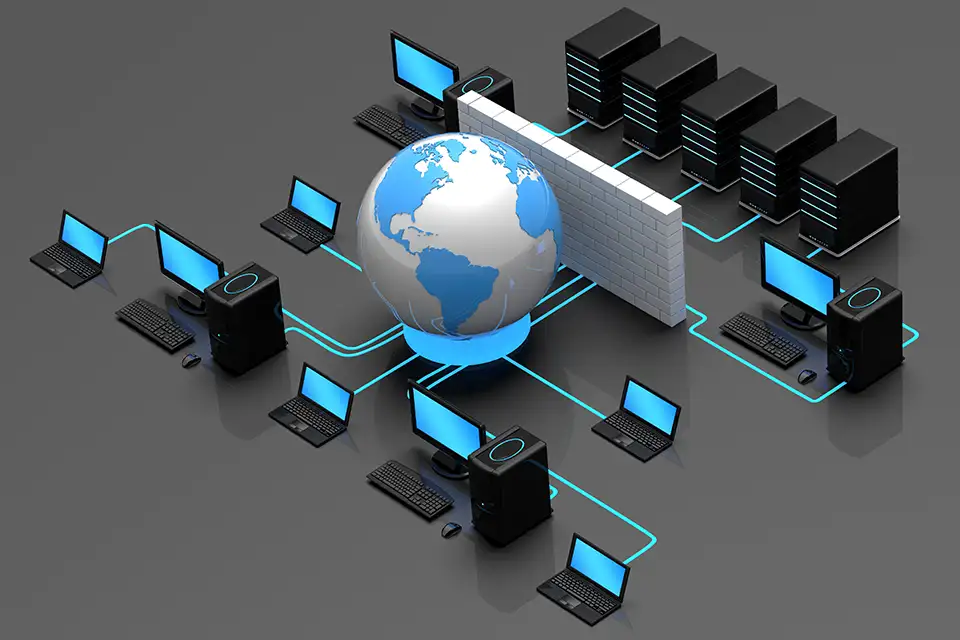Introduction
Looking at the expanding digital infrastructure and an attack surface that increases exponentially, cyber threats could be lurking at every corner. The significance of robust IT security measures is more important today than ever before. Among the critical defence systems, firewalls stand out as the first line of protection, safeguarding the digital assets of individuals and organizations alike.
This article delves into the essence of firewalls—exploring their historical roots, their indispensable role in cybersecurity strategies, and their synergistic relationship with other security measures. Whether you’re an IT security professional or simply keen on understanding the bulwarks that protect our digital domains, join us on this comprehensive journey to unravel the mysteries of firewalls.
Firewall - The Backbone of Digital Defence
Digital Gatekeepers: The Firewall Concept
At its core, a firewall functions as a digital gatekeeper, meticulously analysing and deciding which data packets can enter or leave a network. Imagine a firewall as the discerning bouncer of the digital world, allowing only the VIP (Verified Internet Packets) access, while keeping the dubious characters (malware, unauthorized intruders) at bay. This selective filtering is pivotal in preserving the integrity, confidentiality, and availability of network resources.
The History of Firewalls in Cybersecurity
The inception of firewalls is a tale of innovation spurred by necessity. In the late 1980s, as the internet began to burgeon beyond its academic and military confines, the need for network security mechanisms became glaringly apparent. The term “firewall” itself, originally denoting a physical barrier against fire, was aptly repurposed to describe a system designed to prevent the spread of digital threats.
The journey began with simple packet filters, the predecessors of firewalls. These filters examined the headers of data packets against a set of predefined rules. These early firewalls operated on a basic principle: allow or block data based on rudimentary criteria such as IP addresses and port numbers.
As cyber threats grew in complexity, so did firewalls. The second generation introduced stateful inspection, a more nuanced approach that looked at individual packets and also understood the context of data flows, allowing for more detailed and intelligent security decisions.
The advent of the third generation, or application-layer firewalls, marked a significant leap forward. These firewalls peered deeper, inspecting the payload of packets to ensure that the data adhered to protocol standards and did not carry malicious content. This era also saw the integration of services such as intrusion detection and prevention, making firewalls more versatile than ever.
The Modern Firewall is a Multifunctional Security Hub
The firewalls of today are small marvels of technology, embodying the lessons learned over decades of defending against cyber-attacks. They are no longer standalone entities but part of a larger, integrated security ecosystem. Modern firewalls are equipped with advanced features like deep packet inspection, real-time threat analysis, and even machine learning capabilities to identify and thwart sophisticated attacks. They serve as the nucleus of network security, offering a blend of traditional firewall functions with advanced threat protection, making them indispensable in the contemporary cyber defence arsenal.
In summary, the evolution of firewalls mirrors the trajectory of the internet itself—from humble beginnings to complex systems capable of defending against an ever-growing array of cyber threats. As we continue to navigate the digital age, the role of firewalls in safeguarding our digital frontiers remains as crucial as ever, evolving continuously to counteract the relentless advancement of cyber threats.
The Central Pillar of Cybersecurity Strategy: Firewalls
Protecting Digital Assets - The Multidimensional Role of Firewalls
Firewalls, extend beyond being merely gatekeepers, they are the architects of a secure network, intricately designing the flow of digital traffic to ensure security, efficiency, and compliance with organizational and governmental policies. Their role is multifaceted, extending far beyond the basic filtering of data to a more strategic position within the business’s cybersecurity framework.
Traffic Monitoring and Management: At the heart of firewall functionality is the continuous monitoring of inbound and outbound network traffic. This relentless scrutiny ensures that only legitimate, secure data traverses the network, keeping malicious actors and harmful data at bay.
Policy Enforcement: Firewalls enforce organizational policies by controlling access to network resources based on user roles, source and destination IP addresses, applications, and content types. This ensures that sensitive information and critical systems are accessible only to authorized personnel, thereby mitigating the risk of data breaches.
Threat Prevention and Mitigation: Modern firewalls are equipped with sophisticated mechanisms to identify and neutralize threats in real time. They leverage global threat intelligence to stay abreast of emerging threats, employing advanced algorithms to analyse traffic for suspicious patterns indicative of cyberattacks.
Secure Remote Access: With the increasing prevalence of remote work, firewalls facilitate secure remote access to network resources through Virtual Private Networks (VPNs). This ensures that remote communications are encrypted and secure from eavesdropping or interception, extending the secure perimeter of the network beyond its physical boundaries.
Regulatory Compliance: Firewalls play a pivotal role in ensuring compliance with regulatory standards and industry best practices, such as GDPR, HIPAA, and PCI-DSS. By controlling access, monitoring traffic, and providing detailed logs and reports, firewalls help organizations adhere to stringent data protection and privacy regulations.
The Evolution of the Firewall - Adapting to Dynamic Threats
The evolving nature of cyber threats calls for constant innovation in firewall technologies. The advent of next-generation firewalls (NGFWs) like the ones provided by WiLine in partnership with Fortinet, marked a significant evolution in firewall technology, introducing capabilities that extend well beyond traditional packet filtering. These are four of the most important characteristics you should consider when shopping for a next-generation firewall:
Deep Packet Inspection (DPI): NGFWs perform an in-depth inspection of the data within packets, not just the header information. This allows for a more detailed analysis of traffic, enabling the identification of and protection against sophisticated threats embedded within legitimate data streams.
Application Awareness: Unlike traditional firewalls that control traffic based on port and protocol, NGFWs understand application-level traffic. This allows for more precise control over application use within the network, enabling organizations to block or restrict the use of potentially risky applications.
Integrated Intrusion Prevention Systems (IPS): NGFWs often include IPS capabilities, actively analysing network traffic for signs of intrusion and taking immediate action to block and mitigate such threats. These systems are introducing artificial intelligence (AI) to identify patterns and improve detection rates.
Advanced Threat Protection: Leveraging global threat intelligence and advanced analysis techniques, NGFWs can identify and block emerging threats, including zero-day exploits and advanced persistent threats (APTs), which conventional firewalls may not detect.

The Indispensable Nature of Firewalls in Modern Cybersecurity
The significance of firewalls in today’s cybersecurity landscape cannot be overstated. They serve as the foundation of network security, integrating seamlessly with other security measures to create a comprehensive defence-in-depth strategy. As cyber threats continue to evolve in sophistication and scale, the role of firewalls will continue to grow in importance, adapting to new challenges and continuing to serve as the cornerstone of business’s cybersecurity efforts.
In sum, firewalls are much more than mere barriers; they are the strategic linchpins of cybersecurity, enabling secure, efficient, and compliant digital operations. Their continuous evolution and adaptation are critical in the face of the ever-changing threat landscape, ensuring that organizations can protect their digital assets and maintain the trust of their stakeholders.
The Firewall as Part of A Broader Cybersecurity Strategy
In the intricate tapestry of cybersecurity, firewalls serve as a crucial thread, interwoven with other security measures to create a resilient and robust IT security system. The synergy between firewalls and other cybersecurity facets strengthens the business’s overall security posture while ensuring multi-layered protection against the myriad of cyber threats lurking in the shadows.

Endpoint Security - The First Line of Defence
Endpoint security solutions protect individual devices within the network, such as laptops, smartphones, desktops, and increasingly IoT devices, from malicious software and cyberattacks. When paired with a firewall, which guards the perimeter, this creates a resilient defence strategy that secures both the network’s edge and its internal components.
Integrated Threat Intelligence: Modern endpoint security solutions and firewalls can also share threat intelligence, enabling them to improve the effectiveness of the response to emerging threats. This integrated approach ensures that an attack detected at an endpoint can inform firewall defences, and vice versa, creating a cohesive and dynamic defence mechanism delivering strong protection.
Zero Trust Architecture: The principle of “never trust, always verify” is fundamental to Zero Trust architectures. Firewalls, in conjunction with endpoint security measures, enforce this principle by continuously verifying the security status of devices before granting access to network resources, thereby minimizing the risk of breach from compromised endpoints.
A Multi-Layer Approach to Cybersecurity
Firewalls, while formidable on their own, achieve their full potential when integrated with a broader array of cybersecurity measures. This multi-pronged approach, long advocated by WiLine’s security experts, ensures a depth of protection systems that is much harder for cyber threats to penetrate.
Intrusion Detection and Prevention Systems (IDPS): While some firewalls incorporate IPS capabilities, standalone IDPS solutions offer another layer of analysis and protection, particularly for internal network traffic. This dual-layer protection significantly enhances the ability to detect and respond to sophisticated attacks.
Security Information and Event Management (SIEM): SIEM systems aggregate and analyse log data from various sources, including firewalls, to provide real-time analysis of security alerts. The integration of firewalls with SIEM solutions ensures a comprehensive view of the security landscape, enabling rapid identification and mitigation of potential threats.
Antivirus and Antimalware Solutions: These solutions complement firewall defences by providing endpoint-level scanning and removal of malicious software. The combination ensures that even if malware penetrates the network perimeter, it can be detected and neutralized before causing significant damage.
Data Loss Prevention (DLP): DLP technologies prevent sensitive data from leaving the network unauthorized. When integrated with firewalls, DLP systems can use firewall policies to block or alert on attempts to transmit sensitive information outside the network, adding an extra layer of data protection.
Cloud Access Security Brokers (CASBs): As organizations increasingly adopt cloud services, CASBs provide visibility and control over cloud-based applications. Integrating CASBs with firewalls enables consistent security policies across on-premises and cloud environments, ensuring seamless protection of data, regardless of where it resides.
The WiLine Approach: A Unified Cybersecurity Strategy
The dynamic interplay between firewalls and other cybersecurity measures is akin to a well-coordinated orchestra, where each instrument plays a vital role in the harmony of the overall performance. This holistic approach to cybersecurity ensures that vulnerabilities in one area can be compensated for by strengths in another, creating a resilient and adaptive defence system capable of countering the ever-evolving cyber threat landscape.

In essence, firewalls are the foundation upon which the edifice of cybersecurity is built. However, their true strength lies in how they integrate with a complete suite of IT security measures, ensuring a layered defence that safeguards the digital assets of organizations in the relentless battle against cyber criminals. This unified security strategy not only enhances the effectiveness of each component but also ensures a cohesive and robust defence capable of withstanding the complexities of modern cyber warfare.
Beyond Technology: The Role of Human Expertise
While firewalls and other technological measures are critical components of a cybersecurity strategy, the role of human expertise must not be overlooked. The configuration, monitoring, and management of firewalls require skilled professionals who can interpret complex threat data, make informed decisions about security policies, and respond swiftly to potential breaches.
Crafting and managing firewall policies is a nuanced task that requires a deep understanding of the organization’s network architecture, business processes, and security objectives. Security professionals must balance the need for security with the need for business functionality, ensuring that security measures do not impede legitimate network use. In the event of a breach or attempted breach, the response orchestrated by cybersecurity professionals is crucial.
Firewalls, with their logging and alerting capabilities, provide valuable data that can inform the incident response process, enabling a swift and effective reaction to mitigate the impact of an attack.
The cybersecurity field is one of constant learning and adaptation. Professionals must stay abreast of the latest threats, technologies, and best practices to ensure that firewall configurations and policies remain effective against an ever-evolving threat landscape.
The Keystone of Cyber Resilience
In the grand scheme of cybersecurity, firewalls are more than just a component; they are the keystone of cyber resilience. Their ability to filter traffic, enforce policies, segment networks, and adapt to new threats makes them an indispensable asset in the quest to protect your digital information and infrastructure.
The effectiveness of firewalls, however, is contingent upon their integration within a broader security strategy that includes technological solutions, human expertise, and organizational policies. This holistic approach ensures the security of your most valuable digital assets and the resilience of your organization in the face of cyber threats.
As the digital world continues to evolve and expand, the role of firewalls in safeguarding our digital frontiers remains paramount. Through continuous innovation, in tandem with human expertise and a multi-layered cybersecurity strategy, you would have built the required foundation for navigating the complex and ever-changing landscape of digital security. WiLine can be your cybersecurity partner, ensuring that your organization is equipped to thrive in the digital age with confidence and security.

